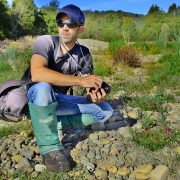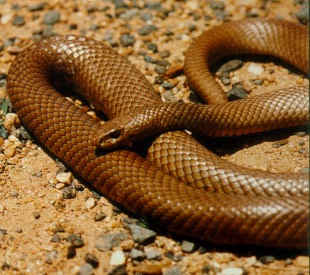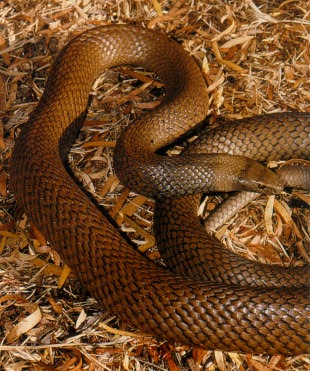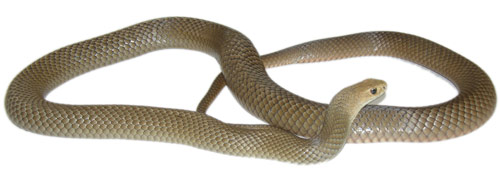


The Brown Snake. That’s it. That’s the best name they could come up with.
It’s our deadliest snake, for Pete’s sake. Why couldn’t they have called it the ‘Goliath Serpent’, or the ‘Tyrannosaurus Viper’? Surely ‘Brown Snake’ far too unglamorous for the snake that has been responsible for more snake bite deaths than any other in Australia.
The main reason it’s so dangerous? It’s as common as mud. The Brown Snake is pretty much everywhere people are, and is often found even in urban areas. The most common variety is called, amazingly, the Common Brown Snake – sometimes it’s known as the Eastern Brown Snake. Either way, it’s pretty obvious that no-one sat up all night trying to figure out a catchy name for it. If you want to sound clever, though, feel free to call it Pseudonaja textilis.
The Common Brown has a couple of close relatives: The Western Brown Snake (Pseudonaja nuchalis), sometimes known more interestingly by its aboriginal name, the Gwardir; and the Dugite (Pseudonaja Affinis), which is a spotted brown snake. There are a few other related species, and whilst still relatively dangerous, they tend to be shyer, less common, less venomous, or less likely to be in contact with humans. Whatever the case, the logic of hanging around to positively identify whether or not it’s a dangerous species is, for most of us, pretty flawed.
While we’re on the subject of identification, think about this: if you show up to a hospital with your snake-bitten friend, the staff will ask you, “what sort of a snake was it?”. You’ll almost invariably say, ‘It was brown and so many feet long’. This is like identifying your car by saying ‘It’s red’. Hospitals have been issued with venom identification kits which allow them to identify the snake by its venom within about thirty minutes. If you don’t get a really good look at the snake, don’t chase it! And don’t try kill it to take with you. The nurse at the hospital will simply scream and faint. (Besides, a high proportion of snake bites are as a result of the victim trying to kill the animal).
Brown snakes are mostly active during the day, except on very hot days. They are far less active during the winter months, but winter sightings are not unheard of. They are generally shy and will avoid contact with humans where possible. Their preferred prey is small mammals – mice and rats in particular – and attacks on humans are almost invariably defensive strikes, either from being stepped on or threatened.
The average fang length of the Brown Snake is 3-4mm, so it’s highly unlikely that this snake will ever pierce the Snakeprotex protective layers (Snakeprotex resisted venom transfer from 10mm fangs in testing!). The normal venom delivery is around 4mg — but the potency of this venom means that even this tiny amount is enough to bring about paralysis, kidney failure and severe internal bleeding. In a few exceptional cases, victims have died at the scene in a very short space of time.
If you’re bitten, or if your companion is bitten, and you’re wearing Snakeprotex, you will probably be fine. Nevertheless, move to a safe area and remove the gaiters. Never touch the traces of venom left on the gaiter with your bare skin. Even the slightest breakage on your skin, when combined with a trace of venom, will see you in the same danger as if you’d been bitten. This venom will dry out, but it is still dangerous and highly toxic and will remain so for months unless denatured correctly. Brown snake venom can be denatured by spraying it methylated spirits.
The Brown Snake. It’s much more than just a brown snake.

Find or share your adventures (or workday) when out and about on Instagram
1800 655 542
Head Office / Warehouse
18 Follett Close,
Mt Barker SA 5251
Australia
Trade & overseas enquiries welcome:
Call +61 8 8188 7800 (GMT +09:30)